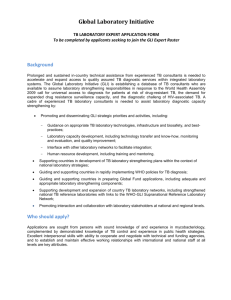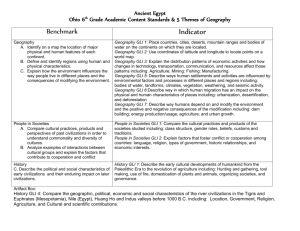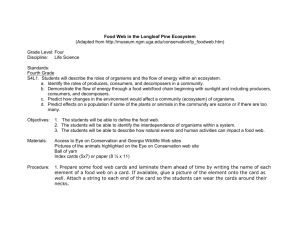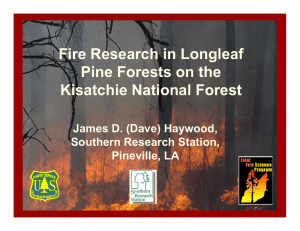The effect of spatially variable overstory on the longleaf pine forest
advertisement
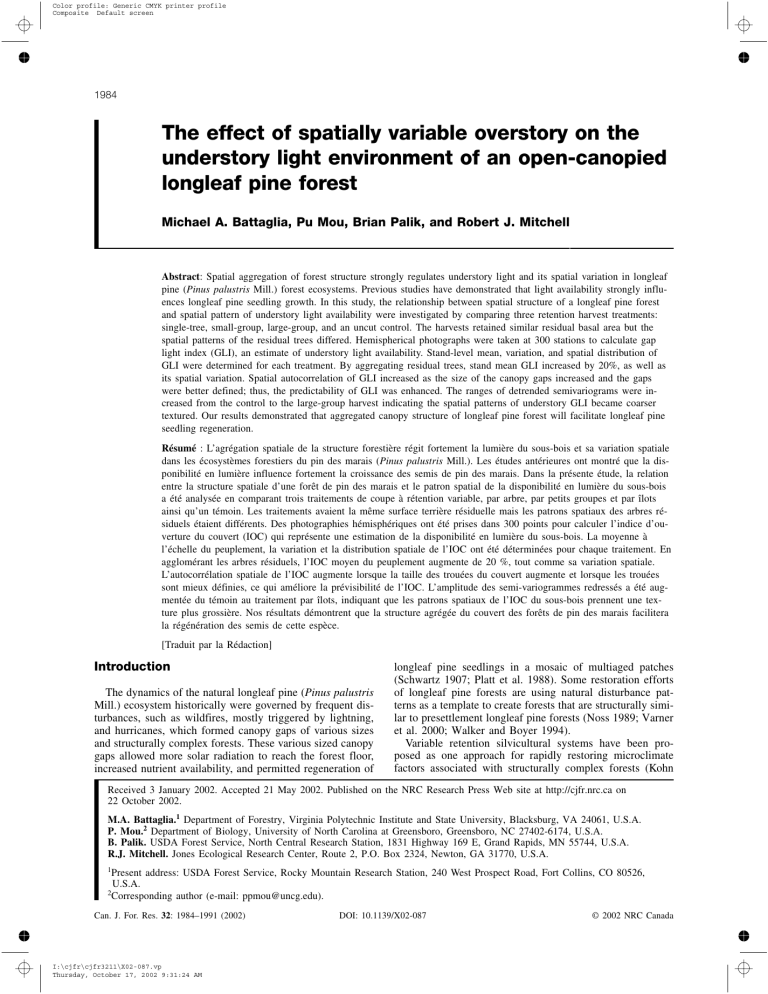
Color profile: Generic CMYK printer profile Composite Default screen 1984 The effect of spatially variable overstory on the understory light environment of an open-canopied longleaf pine forest Michael A. Battaglia, Pu Mou, Brian Palik, and Robert J. Mitchell Abstract: Spatial aggregation of forest structure strongly regulates understory light and its spatial variation in longleaf pine (Pinus palustris Mill.) forest ecosystems. Previous studies have demonstrated that light availability strongly influences longleaf pine seedling growth. In this study, the relationship between spatial structure of a longleaf pine forest and spatial pattern of understory light availability were investigated by comparing three retention harvest treatments: single-tree, small-group, large-group, and an uncut control. The harvests retained similar residual basal area but the spatial patterns of the residual trees differed. Hemispherical photographs were taken at 300 stations to calculate gap light index (GLI), an estimate of understory light availability. Stand-level mean, variation, and spatial distribution of GLI were determined for each treatment. By aggregating residual trees, stand mean GLI increased by 20%, as well as its spatial variation. Spatial autocorrelation of GLI increased as the size of the canopy gaps increased and the gaps were better defined; thus, the predictability of GLI was enhanced. The ranges of detrended semivariograms were increased from the control to the large-group harvest indicating the spatial patterns of understory GLI became coarser textured. Our results demonstrated that aggregated canopy structure of longleaf pine forest will facilitate longleaf pine seedling regeneration. Résumé : L’agrégation spatiale de la structure forestière régit fortement la lumière du sous-bois et sa variation spatiale dans les écosystèmes forestiers du pin des marais (Pinus palustris Mill.). Les études antérieures ont montré que la disponibilité en lumière influence fortement la croissance des semis de pin des marais. Dans la présente étude, la relation entre la structure spatiale d’une forêt de pin des marais et le patron spatial de la disponibilité en lumière du sous-bois a été analysée en comparant trois traitements de coupe à rétention variable, par arbre, par petits groupes et par îlots ainsi qu’un témoin. Les traitements avaient la même surface terrière résiduelle mais les patrons spatiaux des arbres résiduels étaient différents. Des photographies hémisphériques ont été prises dans 300 points pour calculer l’indice d’ouverture du couvert (IOC) qui représente une estimation de la disponibilité en lumière du sous-bois. La moyenne à l’échelle du peuplement, la variation et la distribution spatiale de l’IOC ont été déterminées pour chaque traitement. En agglomérant les arbres résiduels, l’IOC moyen du peuplement augmente de 20 %, tout comme sa variation spatiale. L’autocorrélation spatiale de l’IOC augmente lorsque la taille des trouées du couvert augmente et lorsque les trouées sont mieux définies, ce qui améliore la prévisibilité de l’IOC. L’amplitude des semi-variogrammes redressés a été augmentée du témoin au traitement par îlots, indiquant que les patrons spatiaux de l’IOC du sous-bois prennent une texture plus grossière. Nos résultats démontrent que la structure agrégée du couvert des forêts de pin des marais facilitera la régénération des semis de cette espèce. [Traduit par la Rédaction] Battaglia et al. 1991 Introduction The dynamics of the natural longleaf pine (Pinus palustris Mill.) ecosystem historically were governed by frequent disturbances, such as wildfires, mostly triggered by lightning, and hurricanes, which formed canopy gaps of various sizes and structurally complex forests. These various sized canopy gaps allowed more solar radiation to reach the forest floor, increased nutrient availability, and permitted regeneration of longleaf pine seedlings in a mosaic of multiaged patches (Schwartz 1907; Platt et al. 1988). Some restoration efforts of longleaf pine forests are using natural disturbance patterns as a template to create forests that are structurally similar to presettlement longleaf pine forests (Noss 1989; Varner et al. 2000; Walker and Boyer 1994). Variable retention silvicultural systems have been proposed as one approach for rapidly restoring microclimate factors associated with structurally complex forests (Kohn Received 3 January 2002. Accepted 21 May 2002. Published on the NRC Research Press Web site at http://cjfr.nrc.ca on 22 October 2002. M.A. Battaglia.1 Department of Forestry, Virginia Polytechnic Institute and State University, Blacksburg, VA 24061, U.S.A. P. Mou.2 Department of Biology, University of North Carolina at Greensboro, Greensboro, NC 27402-6174, U.S.A. B. Palik. USDA Forest Service, North Central Research Station, 1831 Highway 169 E, Grand Rapids, MN 55744, U.S.A. R.J. Mitchell. Jones Ecological Research Center, Route 2, P.O. Box 2324, Newton, GA 31770, U.S.A. 1 Present address: USDA Forest Service, Rocky Mountain Research Station, 240 West Prospect Road, Fort Collins, CO 80526, U.S.A. 2 Corresponding author (e-mail: ppmou@uncg.edu). Can. J. For. Res. 32: 1984–1991 (2002) I:\cjfr\cjfr3211\X02-087.vp Thursday, October 17, 2002 9:31:24 AM DOI: 10.1139/X02-087 © 2002 NRC Canada Color profile: Generic CMYK printer profile Composite Default screen Battaglia et al. and Franklin 1997). Application of these systems requires decisions regarding the type, density, and the spatial pattern of the residual trees. Learning more about the interaction of the understory environment with overstory canopy in terms of competition, canopy structure, and light will increase the ability to successfully manage and restore this and other forests (Van Pelt and Franklin 1999). Studies have shown that overstory longleaf pines influence the growth of seedlings through competition for light and nitrogen (Grace and Platt 1995; Palik et al. 1997; McGuire et al. 2001). Palik et al. (1997) and McGuire et al. (2001) reported accelerated seedling growth at gap light index (GLI; a measure of light availability; see below) values greater than 70% (of the GLI in the open). Palik et al. (1997) suggested that standwide growth of regeneration could be maximized by manipulating the spatial arrangement of residual overstory toward a more aggregated distribution, thus increasing the proportion of the area in a stand that has light availability >70%, and minimizing competition from neighborhoods. The spatial distribution of forest canopy structure influences both the total understory light availability and its spatial distribution (Horn 1971; Baldocchi and Collineau 1994; Brown and Parker 1994; Nicotra et al. 1999). The ability to predict spatial variation in understory light environment under a wide range of partial-cutting systems is critical to our ability to predict forest dynamics following harvests; however, this has not been addressed in the longleaf pine ecosystem. Studies in other systems suggest that spatial distribution of light may have great importance for community-level processes such as regeneration (Clark et al. 1996), species composition (Clark et al. 1996), and seedling abundance (Nicotra et al. 1999; Denslow and Guzman 2000). Furthermore, the recognition of spatial dependence variability of light conditions is important in developing spatially explicit models to predict forest dynamics. The purpose of this study was to characterize the understory light environment of a longleaf pine forest after three types of retention harvests. We determined the effects that different spatial arrangements of residual overstory had on the mean, variation, and spatial pattern of understory light availability. The results of this study will assist in the analysis of the role of overstory structure on regeneration processes in longleaf pine ecosystems. We hypothesized (i) gap size would positively correlate with understory light availability; (ii) when the retention harvest intensity is held constant, the stand level mean light availability and variation would increase as residual basal area becomes more aggregated; and (iii) the more aggregated stand would have a coarser scale of variation in understory light availability because of less overstory interception of light. Materials and methods Study area The study was conducted at the Joseph W. Jones Ecological Research Center in southwestern Georgia, U.S.A (31°N, 84°W), from August 1998 to June 1999. It was a part of a larger study investigating the role of overstory structure on regeneration processes in longleaf pine ecosystems. Measurements were taken in a 60- to 80-year-old relatively even aged second-growth forest. The mean height of all trees 1985 >4 cm diameter at breast height (DBH) (n = 2065) was 20.87 ± 0.13 m (mean ± SE). Topography is gentle (1–5% slope) with some limestone sinkholes present. The climate is humid subtropical (Christensen 1981) with a mean annual precipitation of 131 cm, which is relatively evenly distributed throughout the year. Mean daily temperatures range between 21–34°C in summer and 5–17°C in winter. The soils are classified as excessively drained soils of the Orangeburg (fine-loamy, siliceous, thermic Typic Paleudults) and Wagram (loamy, siliceous, thermic Arenic Paleudults) series. The vegetation is maintained with prescribed fire between February and May with intervals ranging from 1 to 3 years, depending on moisture conditions and fuel accumulation. The majority of the overstory consists of longleaf pine with a minor component of oaks (Quercus falcata Michx. and Quercus margaretta Ashe) (Palik and Pederson 1996). The understory is dominated by the perennial grass Aristida stricta Michx. along with many other less important species of perennial grasses and forbs (Goebel et al. 1997). Site selection and harvest treatments Three replicates of four overstory manipulation treatments were used to determine the effects of spatially variable overstory structure on light reaching the understory of longleaf pine ecosystems. The four treatments were randomly assigned to each of three replicates including (i) uncut control (control); (ii) basal area reduction through thinning individual trees (single tree); (iii) basal area reduction that created small canopy gaps -0.10 ha (small group), and (iv) basal area reduction that created larger canopy gaps -0.20 ha (large group). For the three harvest treatments, residual basal area was reduced to a similar level (12.17 ± 0.5 m2/ha) from original mean basal area of 15.5 m2/ha, but the residual overstory varied spatially (Fig. 1). We undertook a complete survey of every tree in the study area in November 1997, recording tree height (m), DBH (cm), and location using a global positioning system (GPS). Exact GPS location of all trees and plot boundaries was accomplished by (i) recording relative location of all trees and plot boundaries using a laser transit system (Sokkisha model No. 3DM3F, accuracy -1 cm; Sokkia Corp., Olathe, Kan.); (ii) recording plot boundaries and a small subset of trees in each plot using a GPS datalogger (accuracy <1 m), and (iii) overlaying the two data sets to convert laser transit data to UTM (universal transverse mercator) space. Laser-transit and GPS data were brought into the geographic information system (GIS), and maps were drawn for each plot. A 5 × 5 m grid was superimposed on the map to determine an overstory abundance index (OAI) for each grid point. The number of grid points among plots varied, ranging from 444 to 533. At all grid points ≥15 m within a plot boundary we calculated a weighted measure of overstory competitor abundance (Stroll et al. 1994) within a 15-m radius (706 m2 area) circle using n [1] OAI = BAi i =1 Di ∑ where OAI is overstory abundance index (cm2/m2), i represents the ith tree of a grid point, BA is basal area of tree i (cm2), D is distance (m) of tree i from the centre of the 5 × © 2002 NRC Canada I:\cjfr\cjfr3211\X02-087.vp Thursday, October 17, 2002 9:31:25 AM Color profile: Generic CMYK printer profile Composite Default screen 1986 Fig. 1. The post-treatment spatial distribution of overstory trees of four of the experimental plots representation of the four treatments in the longleaf pine ecosystem in J.W. Jones Ecological Research Center, Newton, Ga., U.S.A. The solid circles show the location of each tree in the plot as recorded by GPS. Can. J. For. Res. Vol. 32, 2002 Hemiview calculated the amount of light transmittance to the understory based on canopy openness (CGF) by accounting for the location of canopy elements, the diurnal path of the sun, and seasonal changes in sun elevation angle. Parameters used for the estimates of the direct transmission factor (Tbeam) were transmissivity = 0.50 and solar constant = 2510 µmol·m–2·s–1 (Canham 1988; Gendron et al. 1998). Diffuse transmission factor (Tdiffuse) was estimated using the standard overcast sky (SOC) assumption (Anderson 1964) in which the brightness of a point in the sky at zenith angle is three times as bright as that near the horizon. With the estimates of direct and diffuse transmission factors, GLI (Canham 1988) was calculated for each station. The GLI specifies the percentage of incident PAR transmitted through a gap to a point in the understory. GLI is calculated using the following equation (Canham 1988): [2] GLI = [(Tdiffuse × Pdiffuse) + (Tbeam × Pbeam)] × 100 5 m grid point. We constrained D to be no less than 1 m to prevent giving undue weight to trees in close proximity, i.e., <<1 m, to the sample point. OAI gives greater weight to larger trees and trees closer to the measurement point than does a strict basal area measurement. In each of the 12 plots we divided the OAIs into five percentile classes. Within each OAI class we chose five grid points randomly for a total of 25 points in each stand. Light measurements Hemispherical photographs were taken at all stations (n = 300) during July and August (when the forest has the highest LAI) 1998 on calm, cloudless mornings at sunrise or evenings prior to sunset. It was assumed that canopy openings in the coniferous forests do not change significantly throughout the year (Rich 1990). Photographs were taken on Kodak t-400 black and white film with a Nikon 35-mm camera with an attached 180° equidistant fish-eye lens (Sigma 8 mm). The camera was located 1.5 m above the ground on a tripod and was such positioned so that the top of each photograph was oriented toward the north. Negatives were scanned into a computer and edited in Adobe PhotoShop (Adobe Inc., San José, Calif.) to increase the contrast between the foliage and the visible sky (Gendron et al. 1998). A threshold gray level was determined for each photograph to distinguish between the foliage and visible sky to calculate canopy openness. To minimize observation error all photographs were taken, scanned, edited, and analyzed by the same person. With the hemisphere divided into azimuth and zenith sectors of 18°, each photograph was analyzed using the image analysis program Hemiview version 2.1 (Delta-T, Cambridge, U.K.) following standard procedure (Rich et al. 1993; Gendron et al. 1998). where Pdiffuse and Pbeam are the proportions of incident seasonal PAR received at the top of the canopy as either diffuse sky radiation or direct-beam radiation, respectively, and Tdiffuse and Tbeam are the proportions of diffuse and directbeam radiation that are transmitted through the canopy to the understory, respectively. A GLI of zero indicates that there is no gap light in the understory, while a GLI of 100 indicates a totally open site. We assumed that both Pdiffuse and Pbeam were equal to 0.5 for an entire growing season (Machado and Reich 1999; Comeau et al. 1998, Gendron et al. 1998; Canham et al. 1990). Our using GLI to estimate light transmittance in longleaf pine forests as an acceptable surrogate to continuous direct measurements of light availability has been reported in a separate article (Battaglia et al. 2002). Data analysis A linear regression procedure (SAS version 8; SAS Institute Inc., Cary, N.C.) was used to examine the impact of canopy openness on the amount of light transmittance (GLI). Because plots had different distributions of OAI and the points within each plot were grouped into five classes of OAI, frequency percentages of the OAI classes within a plot were used as weighting factors in calculating stand-level statistics (plot mean GLI and variance). Comparisons of average stand-level light availability based on GLI were tested with an ANOVA procedure for randomized complete block design (SAS Institute Inc., Cary, N.C.). Treatment differences in stand-level light availability were determined using Duncan’s multiple range test. For each treatment, the frequency percentage of GLI was determined to examine the spatial distribution of GLI within a treatment. GLI was separated into 10 classes with 5% intervals. Spatial statistics We registered the exact location of each survey station and the location information associated to each GLI measurement allows us to perform geostatistic analyses. Examination of GLI measurements of each plot indicated a trend surface; therefore, we detrended the GLI data sets of the plots from first- or second-order trend surfaces. The detrended GLI data sets of the plots were grouped into four groups based upon the treatments, and the semivariances of © 2002 NRC Canada I:\cjfr\cjfr3211\X02-087.vp Thursday, October 17, 2002 9:31:26 AM Color profile: Generic CMYK printer profile Composite Default screen Battaglia et al. 1987 Fig. 2. Linear relationship between percent canopy gap fraction and gap light index (calculated from hemispherical photographs) in a longleaf pine ecosystem, southwestern Georgia, U.S.A. GLIs were calculated to the maximum distance of 110– 160 m with equal lag distances of 8–11 m by using GS+ software version 3.1a (Gamma Design Software, Mich.). A semivariogram was then developed for each treatment. We normally selected a spherical model for semivariogram development if it achieved a satisfactory fit (r2 > 0.5). The spherical model of semivariogram was also used for estimations of range, sill (Co + C), nugget (Co), and structure strength (SH%) (Isaaks and Srivastava 1989). Structural strength (SH%) was calculated by subtracting the semivariogram nugget (Co) from the sill (Co + C) and dividing by the sill (Dent and Grimm 1999). These semivariogram parameters were compared among the treatments. Then, semivariograms were used to krig the spatial maps of understory GLI for all 12 plots. During kriging, we set kriging resolution as 1 × 1 m. Kriged value at each grid was estimated by using 16 reference station values within the radius a little greater then the corresponding semivariogram range. Results Local-scale influence of canopy openness on understory light The canopy openness significantly affected the amount of light transmitted to the understory. Canopy gap fraction (CGF), calculated as the percentage of sky in the hemispherical photograph field, ranged from 38 to greater than 85%. Within this range, and at the single gap scale, GLI was positively correlated to canopy openness indicated by CGF (Fig. 2). The regression model developed from the data is [3] GLI = 5.3969 + 1.0535(CGF), r2 = 0.86, P(slope ≠ 1) < 0.05 n = 300, RMSE = 16.36 Mean understory light availability at the stand level We have reported in another article (Palik et al. 2002) that mean stand-level GLI varied significantly among the harvest treatments ranging from 49% in the control treatment to 63% in the large-group harvest treatment (Table 1). As gap Table 1. A comparison of mean stand-level light availability (GLI) for each treatment (n = 75 stations for each treatment). Treatment GLI Control Single tree Small group Large group 49.29 56.18 60.48 63.10 (6.09)a (8.16)b (8.24)bc (10.34)c Note: GLI values are means with SDs given in parentheses (rearranged from Palik et al. 2002). Values with different letters are significantly different among treatments as calculated by the Duncan’s multiple range test (α = 0.05). size increased, mean stand GLI increased even though the harvest treatments had approximately the same level of residual basal area. The single-tree harvest resulted in a significantly lower stand-level light availability than the largegroup harvest treatment but not different from that of the small-group harvest (Table 1). Variation of light availability at the stand level Frequency distribution of GLI was left skewed in the control, shifted right in the single-tree treatment, and became normally distributed in the small-group treatment (Figs. 3a, 3b, and 3c). Frequency distributions were more evenly distributed in the large-group treatment (Fig. 3d). The control treatment had the greatest percentage of low GLI stations among all the treatments. Among the harvest treatments, as aggregation of the basal area increased from single tree to large group, the range of GLI increased as well as the percentage of the stations measuring high GLIs. In the control and single-tree harvest treatments, GLI values between 45 and 60% were found in 88 and 81% of the stations, respectively. However, the single-tree harvest had 18% of its stations where GLIs reached the 65–80% level, while none of the stations in the control reached this level (Figs. 3a and 3b). The small-group and large-group harvest treatments had similar ranges of GLI but different frequency distributions. Although GLIs of 50% of stations in both treatments were lower than 60%, GLIs of 30% of stations in the large-group © 2002 NRC Canada I:\cjfr\cjfr3211\X02-087.vp Thursday, October 17, 2002 9:31:26 AM Color profile: Generic CMYK printer profile Composite Default screen 1988 Can. J. For. Res. Vol. 32, 2002 Fig. 3. Percent frequency distribution of gap light index (GLI) for the control (a), single-tree harvest (b), small-group harvest (c), and the large-group harvest (d). harvest treatment reached 75% and greater, while only 15% of the stations in the small-group harvest treatment reached that level (Figs. 3c and 3d). Heterogeneity of understory light environment (patterns of spatial dependence) Geostatistical analyses based on GLI data also revealed distinct differences among the treatments. From the control to the large-group treatment, all semivariogram parameters changed with clear trends. Sills increased from 26.6 to 140.9. Nuggets decreased from 3.5 to almost 0. As a consequence, SH% increased from 88 to almost 100%. The r2 of the semivariograms also increased from 0.26 to 0.89 (Table 2). From the control to the large-group harvest treatment, semivariogram ranges had a similar changing trend (Table 2). The control had the lowest spatial autocorrelation range of 25.8 m. The single-tree harvest treatment and the small-group harvest resulted in a similar autocorrelation range of 38 m, while the range of the large-group harvest doubled it to almost 79 m. Krigged maps demonstrated apparently different spatial patterns of understory light availability (GLI) (Fig. 4). The spatial GLI gradient in the control plot was rather gentle with light and shaded gaps not being well defined. In the large-group harvest the GLI gradient was rather steep and light gaps were obvious. Gaps of GLI in the single-tree and small-group harvest treatments were recognizable but not as well defined as in the large-group harvested plots (Fig. 4). Discussion As expected, the large-group harvest resulted in significantly higher GLIs than the smaller group ones. We found a strong linear relationship between the hemispherical photo- Table 2. Semivariogram spherical model parameters for light availability across each treatment. Treatment Nugget CO Sill (CO + C) Range (m) Structural variability C/(Co + C) (SH%) Control Single tree Small group Large group 3.53 3.10 0.10 0.10 26.55 55.50 58.54 140.90 25.80 38.40 38.70 78.90 0.88 0.94 0.99 1.00 r2 0.256 0.555 0.729 0.893 Note: Lag class was separated into 15 classes of 10 m with a maximum lag distance of 150 m. Co, nugget variance; C/(Co + C), structural variance C as a proportion of model sample variance (Co + C); range, distance (m) over which structural variance expressed autocorrelation. graph estimates of CGF and GLI with a high r2 of 0.86, and a rather steep slope close to 1. This result indicates that local understory light availability is sensitive to canopy gap fraction, even in this naturally open canopied longleaf pine ecosystem. Our results demonstrated that increasing the aggregation of residual basal area not only increases the mean standlevel understory light availability but also increases the variation of light resulting in more heterogeneous understory light environments. It is well known that basal area has a negative relationship to understory light availability in longleaf pine forests (Boyer 1993; Palik et al. 1997). However, the relationship between spatial arrangement of residual trees and stand-level understory light availability has not been examined. In this study, although the harvest treatments, on average, had a 22% reduction in total basal area, the single-tree harvest only had a 12% increase in mean stand-level light availability compared with the uncut control. In contrast, both the small- and large-group harvests © 2002 NRC Canada I:\cjfr\cjfr3211\X02-087.vp Thursday, October 17, 2002 9:31:28 AM Color profile: Generic CMYK printer profile Composite Default screen Battaglia et al. 1989 Fig. 4. Kriged ground-level gap light index (GLI) spatial patterns of four experimental longleaf pine plots representing the four treatments in J.W. Jones Ecological Research Center, Newton, Ga., U.S.A. had an approximate 20% increase. Therefore, reducing basal area in a stand will not simply increase light availability proportional to the reduction indicating that the spatial arrangement of the residual basal area plays a potentially important role. Different retention harvest schemes lead to different spatial arrangements of residual basal area and different distributions of light availability within a stand. For instance, the control treatment was dominated by small and mid-sized canopy openings with no stations that had GLIs exceeding 70%. The single-tree harvest increased the amount of small canopy openings and enlarged some existing openings resulting in a low percentage (-5%) of stations with GLIs exceeding 70%. In contrast, the small-group harvest created some small canopy openings and merged some openings into a few larger ones but with a relatively larger area undisturbed. This resulted in a much lower percentage of stations (50%) that received intermediate light levels (GLI 45–70%) with a much higher frequency (28%) of stations receiving GLI above 70%. In the large-group harvest, the merging of several small or mid-sized openings to form a few large gaps while maintaining some undisturbed areas increased the amount of stations (37%) that received GLIs of 70% and above. These results further support the suggestion that the effects of spatial arrangements of residual overstory on light availability may be best interpreted by examining the frequency distributions rather then the mean light availability (Logan and Peterson 1964; Chazdon and Fetcher 1984; Baldocchi and Collineau 1994; Brown and Parker 1994; Nicotra et al. 1999). The different spatial patterns of GLI created by the four treatments have been clearly characterized by the geostatistical analyses. Examining the semivariograms demonstrated that as residual basal area became more aggregated, the total variation of light availability (indicated by semivariogram sill; Table 2) substantially increased. A semivariogram sill is theoretically equivalent to the variance of the spatial samples (Rossi et al. 1992; Isaaks and Srivastava 1989). This increase in the sill was due to the concurrent formation of large openings while maintaining undisturbed microsites that greatly expanded the GLI variation within the treatment. Both the small- and large-group harvests created many microsites with high GLIs (>70%) and lead to much higher semivariogram sills, while few such microsites were created by the single-tree harvest and resulted in a limited increase of semivariogram sill (Table 2). © 2002 NRC Canada I:\cjfr\cjfr3211\X02-087.vp Thursday, October 17, 2002 9:31:32 AM Color profile: Generic CMYK printer profile Composite Default screen 1990 In contrast, the semivariogram nuggets constantly decreased from the control to the large-group harvest. As a consequence, the SH%, which is used in evaluating the strength of spatial dependence (Li and Reynolds 1995; Dent and Grimm 1999), drastically increased to almost 1 (99.99%). This is mainly due to the formation of new gaps by the harvests either reinforcing the original spatial structure of the canopy, such as single-tree harvest, that made the spatial dependence of the existing understory light pattern stronger; or creating new spatial canopy structures, such as small- and large-group harvests, that created strongly spatially dependent understory light patterns. We observed in the field that in the harvested plots, canopy gaps had much clearer boundaries than control plots. This indicated that the gaps were spatially defined, and there were spatial patterns of understory light as well. Such enforcing impacts on GLI spatial pattern was also reflected in the large increases of r2’s of the semivariogram models for the harvested plots (Fig. 4, Table 2). Semivariogram ranges of understory GLI increased as residual canopy trees became more aggregated. The control plots had the shortest range among the four treatments, while the large-group harvest had the longest. The shortest semivariogram range of the control treatment and the longest semivariogram range of the large-group harvest may reflect light patches of different sizes in the plots of the two treatments. Both semivariogram ranges of single-tree harvest and small-group harvest were comparable and were between that of control and large-group harvest. We expected that the small-group harvest would create a few more larger gaps leading to a greater semivariogram range; Dent and Grimm (1999) have suggested that semivariogram range indicated mean patch size. The similar semivariogram ranges may show that semivariogram range is an insensitive index for mean patch size. Recent studies (Guo et al. 2002) questioned the robustness of using semivariogram range to indicate patch size. Implications for longleaf pine seedling growth and future forest structure Differences in canopy openings and the subsequent distribution of light availability are important to longleaf pine seedling growth and structure of the future forest. Palik et al. (1997) and McGuire et al. (2001) suggested standwide growth of regeneration could be maximized by manipulating the spatial arrangement of residual overstory toward a more aggregated distribution, thus increasing the proportion of the area in a stand that has light availability >70%. In this study, as the residual overstory became more aggregated, the proportion of the stations with GLI of greater than 70% increased from 5% in the single-tree harvest to 37% in the large-group harvest. We used the regression model between seedling biomass increment and GLI developed by Palik et al. (1997) to predict seedling biomass growth for all microsites where our stations were located. The model predicted that maximum mean seedling growth would occur in the large-group harvest treatment (Table 3). In fact, by aggregating the residual basal area, the model predicted that the large-group harvest would have a substantially higher (32%) stand-level seedling growth than the single-tree harvest (Table 3) and small-group harvest (16%). This trend has been Can. J. For. Res. Vol. 32, 2002 Table 3. Predicted seedling growth for each treatment based on the relationship between gap light index and seedling growth reported in Palik et al. (1997). Treatment Seedling growth (g/year) Control Single tree Small group Large group 3.22 3.81 4.34 5.03 (0.397)a (0.434)ab (0.648)b (0.956)c Note: Values are means with SD given in parentheses. The equation is as follows: seedling growth (g) = 1.64/(1 – 0.0098 × GLI), r2 = 0.39. Values with different letters are significantly different among treatments as calculated by the Duncan’s multiple range test (α = 0.05). generally confirmed by our recent field data collected from controlled experimental plots (Palik et al. 2002). This simulation was based on the scenario excluding the competitive interactions between longleaf pine seedlings and other species growing alongside it. The understory of a longleaf pine forest is dominated by C4 graminoids that also respond positively to high light environments (McPherson and Weltzin 1998; McGuire et al. 2001) and also have greater water use efficiency (Mitchell et al. 1999). In areas of low residual basal area, more direct light can reach the understory, which in turn will increase evapotranspiration and, thus, lower soil moisture. Therefore, the combination of higher light and lower soil moisture in areas of low residual basal area may actually give C4 plants a competitive advantage over longleaf pine seedlings. Since the limiting resource for C4 plants is light, altering the residual basal area that inhibits C4 carbon gain while allowing longleaf pine seedlings to maximize carbon gain will be a delicate work. At this moment, the lack of data describing the photosynthetic response of longleaf pine and other competitors in this system to different light levels inhibits our ability to precisely predict competitive outcomes. Acknowledgements We are grateful to two anonymous reviewers and Dr. R.H. Jones for reviewing the draft. We also thank Stacy Hurst and Stephen Pecot for their assistance in the field and laboratories. We are indebted to the help and support from the J.W. Jones Ecological Research Center. This research was financially supported by a USDA NRI grant (grant No. 97-35101-4419). References Anderson, M.C. 1964. Studies of the woodland light climate. II. Seasonal variation in the light climate. J. Ecol. 52: 643–663. Baldocchi, D., and Collineau, S. 1994. The physical nature of solar radiation in heterogeneous canopies: spatial and temporal attributes. In Exploitation of environmental heterogeneity by plants: ecophysiological processes above and below ground. Edited by M.M. Caldwell and R.W. Pearcy. Academic Press, New York. pp. 21–71. © 2002 NRC Canada I:\cjfr\cjfr3211\X02-087.vp Thursday, October 17, 2002 9:31:32 AM Color profile: Generic CMYK printer profile Composite Default screen Battaglia et al. Battaglia, M.A., Mitchell, R.J., Mou, P., and Pecot, S.D. 2002. Light transmittance estimates in a longleaf pine woodland. For. Sci. In press. Boyer, W.D. 1993. Long-term development of longleaf pine seedlings under pine seed tree and shelterwood stands. South. J. Appl. For. 17: 10–15. Brown, M.J., and Parker, G.G. 1994. Canopy light transmittance in a chronosequence of mixed-species deciduous forests. Can. J. For. Res. 24: 1694–1702. Canham, C.D. 1988. An index for understory light levels in and around canopy groups. Ecology, 69: 1634–1638. Canham, C.D., Denslow, J.S., Platt, W.J., Runkle, J.R., Spies, T.A., and White, P.S. 1990. Light regimes beneath closed canopies and tree-fall groups in temperate and tropical forests. Can. J. For. Res. 20: 620–631. Chazdon, R.L., and Fetcher, N. 1984. Photosynthetic light environments in a lowland tropical rainforest in Costa Rica. J. Ecol. 72: 553–564. Christensen, N.L. 1981. Fire regimes in southeastern ecosystems. In Fire regimes and ecosystem properties. Edited by: H.A. Monney, T.M. Bonnickse, N.L. Christensen, J.E. Lotan, and W.A. Reiners. USDA For. Serv. Gen. Tech. Rep. WO-26. pp. 112–136. Clark, D.B., Clark, D.A., Rich, P.M., Weiss, S., and Oberbauer, S.F. 1996. Landscape-scale evaluation of understory light and canopy structure: methods and application in a neotropical lowland rain forest. Can. J. For. Res. 26: 747–757. Comeau, P.G., Gendron, F., and Letchford, T. 1998. A comparison of several methods for estimating light under a paper birch mixedwood stand. Can. J. For. Res. 28: 1843–1850. Denslow, J.S., and Guzman, S.G. 2000. Variation in stand structure, light and seedling abundance across a tropical moist forest chronosequence, Panama. J. Veg. Sci. 11: 201–212. Dent, C.L., and Grimm, N.B. 1999. Spatial heterogeneity of stream water nutrient concentrations over successional time. Ecology, 80: 2283–2298. Gendron, F., Messier, C., and Comeau, P.G. 1998. Comparison of various methods for estimating the mean growing season percent photosynthetic photon flux density in forests. Agric. For. Meteorol. 92: 55–70. Goebel, P.C., Palik, B.J., Kirkman, L.K., and West, L. 1997. Field guide: landscape ecosystem types of Ichauway. Joseph W. Jones Ecological Research Center at Ichauway, Newton, Ga. Tech. Rep. 97-1. Grace, S.L., and Platt, W.J. 1995. Effects of adult tree density and fire on the demography of pregrass stage juvenile longleaf pine (Pinus palustris Mill). J. Ecol. 83: 75–86. Guo, D., Mou, P., Jones, R.H., and Mitchell, R.J. 2002. Temporal changes in spatial patterns of soil moisture following disturbance: an experimental approach. J. Ecol. 90: 338–347. Horn, H.S. 1971. The adaptive geometry of trees. Princeton University Press, Princeton, N.J. Isaaks, E.H., and Srivastava, R.M. 1989. Applied geostatistics. Oxford University Press, New York. Kohn, K.A., and Franklin, J.F. 1997. Creating a forestry for the 21st century: the science of ecosystem management. Island Press, Washington, D.C. Li, H., and Reynolds, J.F. 1995. On the quantification of spatial heterogeneity. Oikos, 73: 280–284. Logan, K.T., and Peterson, E.B. 1964. A method of measuring and describing light patterns beneath the forest canopy. Can. Dep. For. For. Branch For. Res. Div. Tech. Note 1073. 1991 Machado, J., and Reich, P.B. 1999. Evaluation of several measures of canopy openness as predictors of photosynthetic photon flux density in deeply shaded conifer-dominated forest understory. Can. J. For. Res. 29: 1438–1444. McGuire, J.P., Mitchell, R.J., Moser, E.B., Pecot, S.D., Gjerstad, D.H., and Hedman, C.W. 2001. Gaps in a gappy forest: plant resources, longleaf pine regeneration, and understory response to tree removal in longleaf pine savannas. Can. J. For. Res. 31: 765–778. McPherson, G.R., and Weltzin, J.F. 1998. Herbaceous response to canopy removal in southwestern oak woodlands. J. Range Manage. 51: 674–678. Mitchell, R.J., Zutter, B.R., Gjerstad, D.H., Glover, G.R., and Wood, C.W. 1999. Competition among secondary-successional pine communities: a field study of effects and responses. Ecology, 80: 857–872. Nicotra, A.B., Chazdon, R.L., and Iriarte, S.V.B. 1999. Spatial heterogeneity of light and woody seedling regeneration in tropical wet forests. Ecology, 80: 1908–1926. Noss, R.F. 1989. Longleaf pine and wiregrass: keystone components of an endangered ecosystem. Nat. Areas J. 9: 211–213. Palik, B.J., and Pederson, N. 1996. Overstory mortality and canopy disturbance in longleaf pine ecosystems. Can. J. For. Res. 26: 2035–2047. Palik, B.J., Mitchell, R., Houseal, G., and Pederson, N. 1997. Effects of canopy structure on resource availability and seedling responses in a longleaf pine ecosystem. Can. J. For. Res. 27: 1458–1464. Palik, B., Mitchell, R.J., Pecot, S., Battaglia, M., and Mou, P. 2002. Spatial distribution of overstory retention influences resource availability and seedling growth: a silvicultural experiment using longleaf pine. Ecol. Appl. In press. Platt, W.J., Evans, G.W., and Rathbun, S.L. 1988. The population dynamics of a long-lived conifer (Pinus palustris Mill.). Am. Midl. Nat. 131: 491–525. Rich, P.M. 1990. Characterizing plant canopies with hemispherical photographs. Remote Sens. Rev. 5: 13–29. Rich, P.M., Clark, D.B., Clark, D.A., and Oberbauer, S.F. 1993. Long-term study of solar radiation regimes in a tropical wet forest using quantum sensors and hemispherical photography. Agric. For. Meteorol. 65: 107–127. Rossi, R.E., Mulla, D.J., Journel, A.G., and Franz, E.H. 1992. Geostatistical tools for modeling and interpreting ecological spatial dependence. Ecol. Monogr. 62: 277–314. Schwartz, G.F. 1907. The longleaf pine in virgin forest. John Wiley & Sons, New York. Stroll, P., Weiner, J., and Schmid, B. 1994. Growth variation in a naturally established population of Pinus sylvestris. Ecology, 75: 660–670. Van Pelt, R., and Franklin, J.F. 1999. Response of understory trees to experimental groups in old-growth Douglas-fir forests. Ecol. Appl. 9: 504–512. Varner, J.M., III., Kush, J.S., and Meldahl, R.S. 2000. Ecological restoration of an old-growth longleaf pine stand utilizing prescribed fire. Proc. Tall Timbers Fire Ecol. Conf. 21: 216–219. Walker, J.L., and Boyer, W.D. 1994. An ecological model and information needs assessment for longleaf pine ecosystem restoration. In Silviculture: from Cradle of Forestry to Ecosystem Management: Proceedings of the National Silviculture Workshop, 1–4 Nov. 1993, Hendersonville, N.C. USDA For. Serv. Gen. Tech. Rep. SE-88. pp. 138–147. © 2002 NRC Canada I:\cjfr\cjfr3211\X02-087.vp Thursday, October 17, 2002 9:31:33 AM


